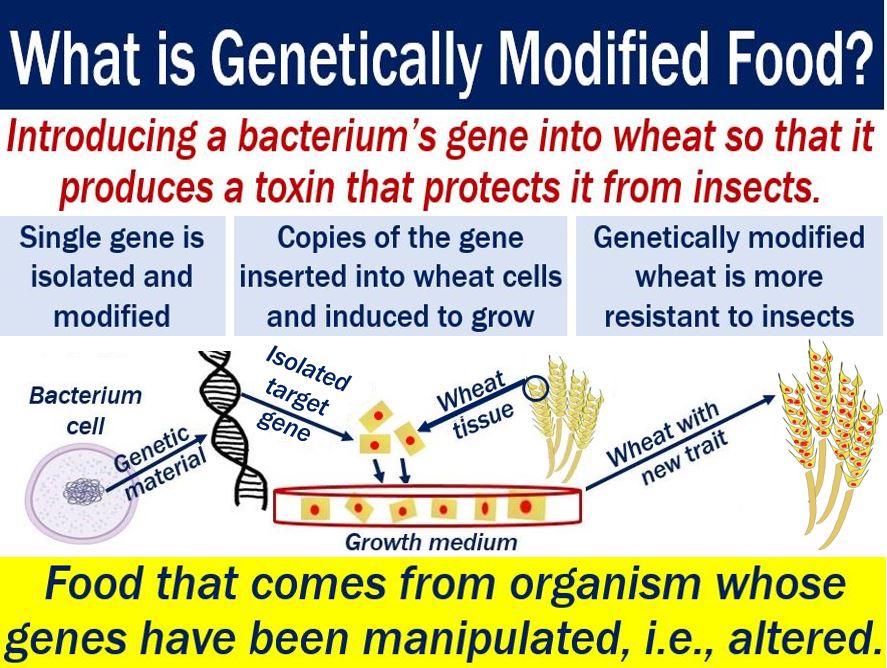What is genetically modified food?
Genetically modified food (GM food) is food that scientists have altered genetically. Specifically, genetic engineers have manipulated the genes of the source of the food. For example, if it is milk, they have altered the genetic material of the cow. If it is bananas, they have altered the genetic code of the banana tree.
The genetic code is the set of rules that encodes information within DNA that living cells translate into proteins. In fact, our genetic code determines whether we are tall, short, blonde, brown-haired, susceptible to certain diseases, etc.
In other words, it determines what we look like and how we behave. It even determines whether we are optimists or pessimists.
We call the technology of altering an organism’s DNA ‘recombinant DNA technology‘ or ‘genetic engineering.’ We also call it ‘gene technology‘ or ‘modern biotechnology.’
Food biotechnology involves modifying the genes of the animals and plants that we eat. It is thanks to food biotechnology that some crops, for example, are more disease-resistant.
Genetic engineering allows scientists to transfer individual genes from one organism to another. In fact, geneticists can even do this between completely different species.
Why produce genetically modified food?
We develop and market genetically modified food because we believe there is an advantage. In other words, there is a benefit either for the producer, consumer, or both.
Typically, the advantage is lower price, superior nutritional value, and longer durability of the food.
Developers of GM seeds strive to create seeds that producers want. Genetic engineers focus on innovations that bring direct benefit to the food industry, and above all, farmers.

Crop protection
One of the aims for developing GM plants is to make crops more resistant.
Hundreds of billions of dollars’ worth of crops are lost every year globally because of disease, drought, frost, and insects.
Scientists focus their research on crop protection through the introduction of resistance against diseases. These diseases, which germs and insects cause, decimate crops.
The genetically modified food sector also attempts to make crops more resistant to herbicides.
According to WHO, scientists make plants more insect-resistant by incorporating the gene for toxin production. Specifically, toxin production from bacillus thuringiensis, a bacterium. WHO stands for the World Health Organization.
The bacterium’s toxin is safe for humans to consume. In fact, farmers currently use it as a conventional insecticide.
Crops that have this toxin-producing gene require less quantity of insecticides, studies show.
Scientists can make a plant more resistant to viruses by introducing a gene from some disease-causing viruses. Subsequently, the plant’s immunity improves. In other words, it becomes less susceptible to diseases that certain viruses cause.
Healthier crops mean greater yields.
WHO says that scientists achieve greater herbicide tolerance in plants:
“Through the introduction of a gene from a bacterium conveying resistance to some herbicides. In situations where weed pressure is high, the use of such crops has resulted in a reduction in the quantity of the herbicides used.”
Concern regarding genetically modified food
Many parts of the world, including the United States, embraced genetic engineering for agriculture fairly rapidly.
The European Union, however, has been apprehensive. Many Europeans worry about tweaking with organisms’ genes.
Across the whole world, environmentalists and health advocates have been warning about the dangers of genetically modified food for years.
One major concern is that as soon as you plant GM seeds, you cannot get rid of them.
GM seeds become GM plants, which are better at surviving and thriving than non-GM plants. Therefore, if you sow them in one field, it won’t be long before that plant has pushed out its non-GM counterpart.
There is some truth in that concern. However, genetically modified food companies and GM seed sellers insist their products are safe, and often superior to their non-GM counterparts.
Are genetically modified foods safer?
Let’s suppose bread from GM crops lasts twice as long as bread from non-GM crops. This means that fewer people will get ill from moldy bread.
Longer-lasting fruit, vegetables, meat, and fish take longer to rot. Therefore they are less likely to make humans ill, i.e., they are safer.
Genetically modified seeds mean that today, in some parts of the world, there are farms that did not exist before.
They did not exist because there was not enough water. However, the GM crops thrive in arid or semi-arid conditions.
Video – what is genetically modified food?
This Scientific American explains what genetically modified food is. Health advocates and environmentalists have been demonizing GM foods every since the technology appeared.

